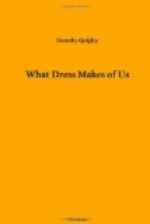[Illustration: No. 16]
For Faces with Protruding Noses.
Women with decidedly protruding, or irregular, tip-tilted noses should be especially careful in arranging their coiffures.
Any woman who arranges her hair as in sketch No. 16 caricatures her facial defects by increasing the too protuberant lines of her nose. The distance from the end of her nose and the tip of the topmost knot of hair is too long for either beauty or intelligence. The shape of her head acquires idiotic proportions, and her nose is placed entirely “out of drawing” and is obtrusively conspicuous when seen in profile. This type of woman is generally classified among the inquisitive, bright, and energetic. She should aim to modify the unhappy angularity of her profile as well as to repress her gossipy tendencies. The graduated coil of hair and waved coiffure, shown by No. 17, are most felicitous in their effect on this type of face.
[Illustration: No. 17]
[Illustration: No. 18]
No. 18 reveals an error in an opposite direction. The snubbed-nose girl, by fixing her hair in a bun-like coil, gives the impression that her coiffure is held by invisible strings by her nose, which gets a more elevated look than it otherwise would have, because of the bad angle at which the coil is placed.
[Illustration: No. 19]
No. 19, which is a picturesque variation of the popular coif, manifestly improves this type of face, and makes the nose appear less obtrusive.
A woman should carefully study the contour of her head from every side; the modelling of her face; the length and inclination of her nose; the setting of her eyes; and the breadth and form of her brow, and adopt a becoming coiffure that will give artistic balance to her face, and never absolutely change the style whatever the mode in hair-dressing may be. In England, the court hair-dresser years ago studied the character of the head and face of the Princess of Wales, and designed a coiffure for her which she has never varied until recently; then she merely arranged her fringe lower down on her forehead than she has ever worn it before. The general style, however, she preserves intact, and wears her hair, and has for many years, as is shown in the picture—No. 20. Her daughters, who have faces the same shape as hers, dress their coiffures similarly. In never changing the style of arranging her hair, the Princess of Wales owes in no small degree her apparent air of youthfulness.
[Illustration: No. 20]
No matter what the prevailing
style these rules may be practically
applied.
CHAPTER II.
HINTS FOR THE SELECTION OF BECOMING AND APPROPRIATE STYLES IN HEAD-GEAR.




